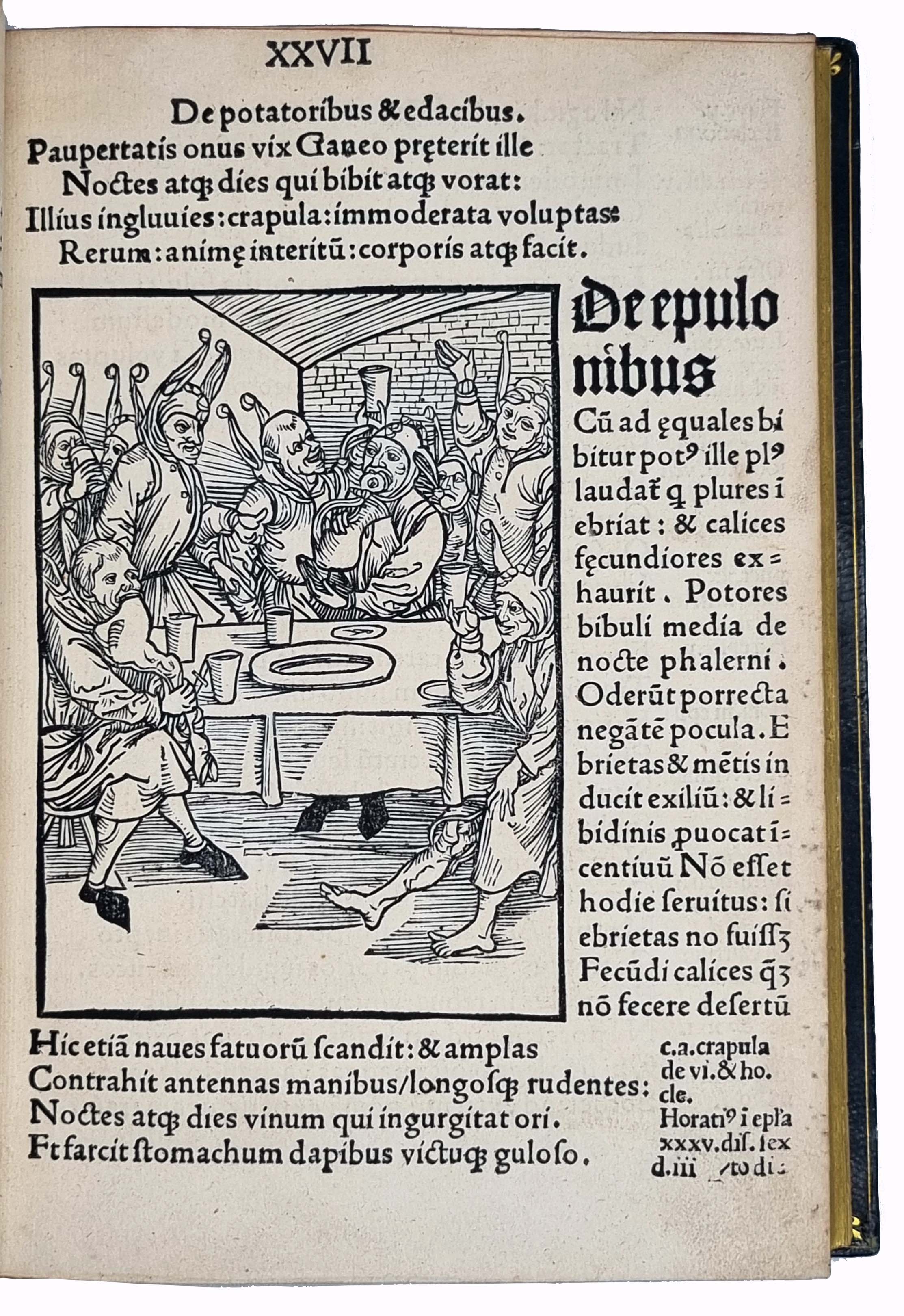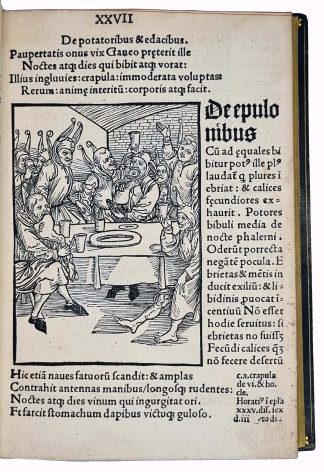BRANT, Sebastian.
LAVISHLY ILLUSTRATED INCUNABULAR AMERICANUM
Stultifera navis
Basel, Johann Bergmann, de Olpe, 1497£32,500.00
4to. ff. 159, wanting final blank. Gothic letter. T-p with superb half-page woodcut of Ship of Fools, another 117, full-page or smaller, portraying the Fools in their various satirical occupations, handsome woodcut printer’s device to verso of X4. T-p and margins of first two ll. a little soiled, small expert repair touching a handful of letters (couple partly supplied in ink on verso of t-p), upper and outer edge of first two gatherings a trifle frayed, intermittent light oil stain towards upper margin, small clean tear from outer edge of e8 just touching two words, annotations removed from first leaf of Registrum. A very good copy in early C19 crushed green morocco, sympathetically rebacked with onlaid spine, blind tooled to a panel design, title gilt-lettered to covers, raised bands, spine tooled in blind. Bookplate of S.H. Hodgson (1832-1912) and Rugby School (Hodgson bequest) to front pastedown, the odd C16 editorial annotation.
A landmark of early printing, with superb woodcut illustrations partly attributed to the young Dürer, as well as with early references to Columbus’s discoveries and, for the first time in this first enlarged Latin edition, a poem on the Ottoman threat. A German humanist from Strasbourg, Sebastian Brant (1458-1521) completed his studies at Basel. There, until 1500, he published his major works, the most renowned of which, ‘Das Narrenschiff’, in 1494. The humanist Jakob Locher translated it into Latin as ‘Stultifera navis’ in March 1497, adding four woodcuts and—in this fifth and first enlarged Latin edition—also a new poem by Brant, ‘De pereuntibus’. ‘Stultifera navis’ is a powerful satirical poem. ‘In a ship laden with one hundred fools, steered by fools to the fools’ paradise of Narragonia, Brant satirizes all the weaknesses, follies and vices of his time. Composed in popular humorous verse and illustrated by a remarkable series of woodcuts—of which 75 are now attributed to the young Dürer—the book was an immediate success’ (PMM 37). The nautical theme was probably strengthened under the influence of contemporary debates on voyages of exploration and the vanity of seeking knowledge of God’s creation. Most famous is the chapter on the ‘inquisition of geographical regions’, or the foolishness of those who want to measure the earth, illustrated by a fool’s-capped figure holding a compass. It also mentions Columbus’s recent discoveries, which had first appeared in print in his letter to Ferdinand and Isabella of 1493, reprinted by Bergmann, Brant’s Basel publisher, in 1494. The verse states that Ptolemy, Pliny and Varro were all wrong, and the ‘terra’ that was previously ‘incognita’ was now revealed; these Western Hesperides now belonged to King Ferdinand. Brant’s new and final poem, ‘De pereuntibus’, deals with the Ottoman threat, and bears a separate t-p with figures engaged in foolish activities and a diagrammatic horoscope. After foreseeing a nefarious planetary conjunction on 2 October 1503, he bemoans the dangers in which Christianity has been cast by the Turks’ ‘irruptio’ and argues for the support of the Emperor Maximilian in his fight against them. A lavishly illustrated important work and a fascinating edition.
PMM 37 (1494 ed.); Goff B1090; HC 3750*; ISTC ib01090000; Alden 497/5; Church 13 (first Latin ed. of March 1497); Harrisse, Additions, 5 (first Latin ed. of March 1497). Not in BMC XV or Sabin. Göllner does not mention it in the C15 section of his introduction.In stock







